Electronic Health Records System for India
Research / Design strategy / Product design / Healthcare
The personal health record (PHR) is an electronic, universally available, lifelong resource of health information needed by individuals to make health decisions.
Practo, Bangalore
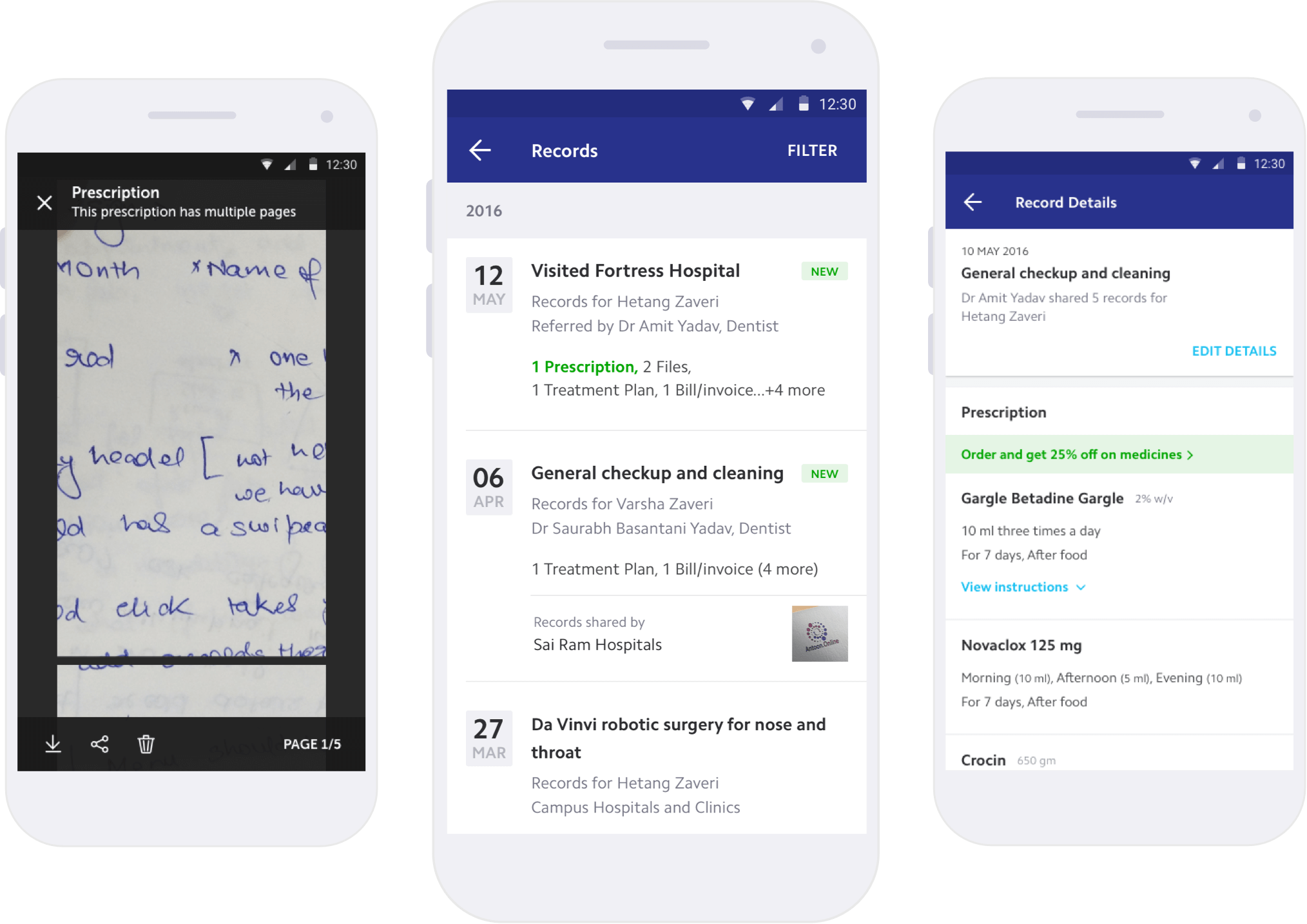
What is PHR?
The personal health record (PHR) is an electronic, universally available, lifelong resource of health information needed by patients to make health decisions. Patients own and manage the data in the PHR, which comes from healthcare providers and the patient. The PHR is maintained in a secure and private environment, with the patient determining rights of access.
PHR at Practo
- Health record as a feature was launched on the mobile application in 2015.
- Since then, we have shipped six significant updates of the records module on to the app and have built a similar experience on the web platform of Practo as well. PHR has proven to be one of the most loved features of the Practo app.
Team & Role
- Timeline and duration: September 2014 - December 2016 (15 months)
- Deliverables: I was one of the initial members of the PHR team here at Practo. I was involved in comprehensive user research, data analytics, expert interviews, competitor analysis, prototyping, and usability testing.
- I built the record sharing and storing tool when Hetang, a fantastic designer from Genii, joined me to increase the usability of the feature and to take it to the next step.
Identifying the user
Early ethnographic research showed that our primary user group would be patients with recurring medical issues. This reminded me of my mother, who has been fighting a chronic disease for the past 15 years. I have seen the troubles that she has had to face. Maybe this was the most significant push for me to join Practo and help create the world's most comprehensive PHR product. This also instigated our research towards chronic patients.
I performed a lot of market research, worked through our analytics and data, spoke to doctors and other providers before coming up some extremely staggering issues. Chronic patients have numerous records from several problem areas. They find it troublesome to keep track of doctor visits, prescriptions, and medicines. Moreover, there is no straightforward way for them to prompt them to do their daily chores. Hence my next step was to dig deeper into to find their problems.

Identified persona for PHR
Understanding the problem
I interviewed 40 patients with various chronic diseases such as Asthma, Arthritis, Diabetes, etc. Surprisingly, most of them had very comparable pain points. I inquired about their everyday routine and the way they maintained and stored their health records through diary studies. This assisted me to infer the immense amounts of obstacles and hardships these patients face every single day due to the age-old health system.
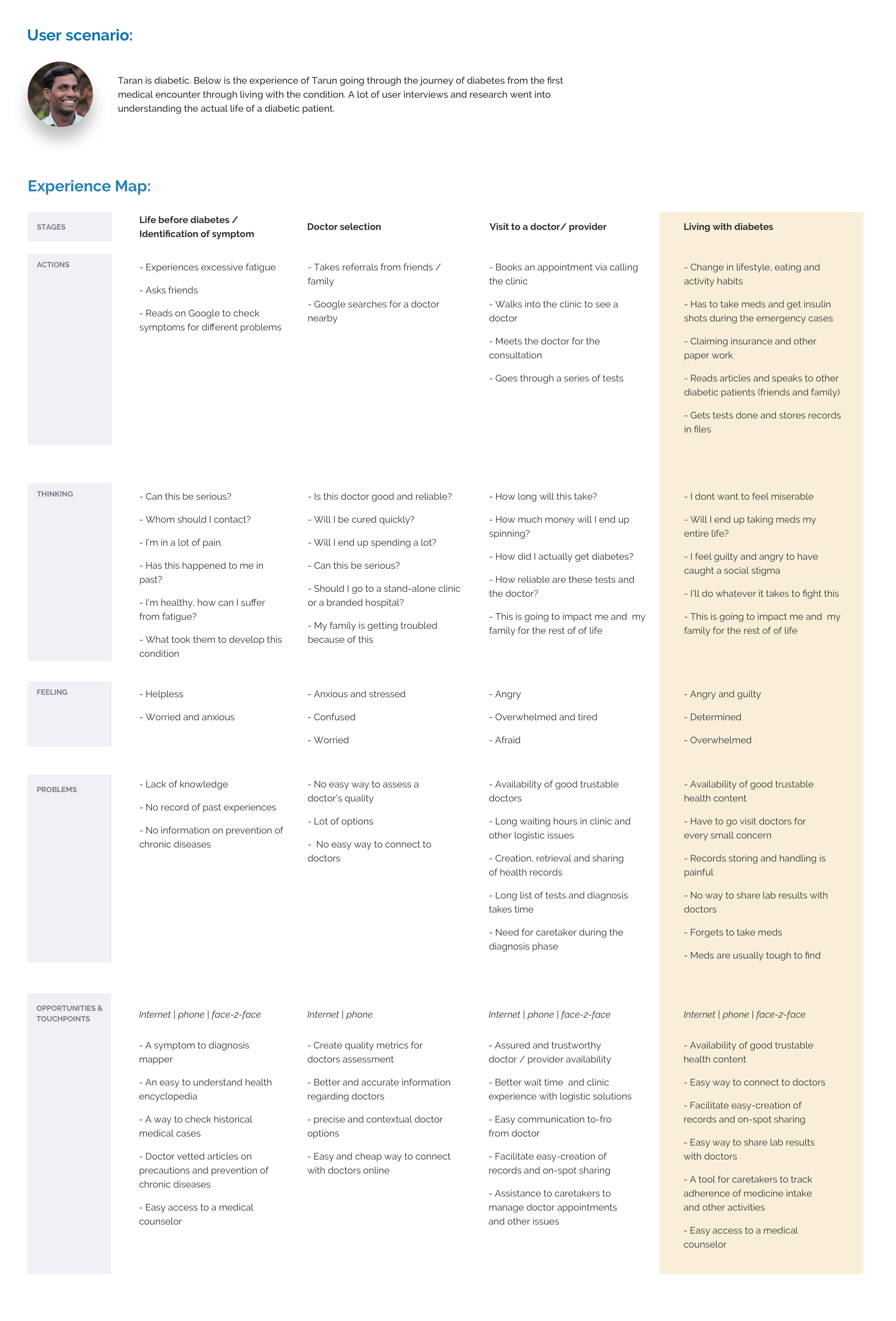
Detailed user journey for a diabetic chronic patient
The rest of the Practo app worked for the initial three stages of the journey. PHR was focused entirely on stage 4 of the chronic patient's journey. To determine and prioritize the most critical user flows, I used the Red Routes analogy defined by Dr. Travis. The darkest marked routes, in the Red Route analysis chart, are the behaviors that are most critical to our users.

Red route analysis was done on the user journey for a diabetic patient
After this activity, I determined which all user behaviors and actions are of prime significance to them. We considered the technical feasibility and Practo's long-term strategy as well in this prioritization process. This was done in collaboration with the Product Managers, Technical Leads, and the Strategist of Practo. Going deeper into these actions, I created a list of major problems which our solution attempted to fix.
The plan here was to break the complex, wicked problem into extremely small entities which could be tackled individually and independently.
- Sharing of records happens physically in the form of enormous bundles of paper
- Storing is done in physical folders which is easy to misplace and not easy to carry around
- Records are difficult to understand for patients
- Medical folders do not give a snapshot of the patient’s health. Doctors need to spend minutes before understanding the patient’s health journey
- Tough to search or retrieve something from these folders
- Patients need to rely on family members to remind them to buy and take medicines
- Medical folders are easily damaged and hence not secure
- Records are stored chronologically in folders, while doctors suggest them to be stored via problems
- No way to see trends and analyze progress on vital signs and billing is a chaotic and time-consuming process
Easy record creation and sharing
Our first response to the problem was to tackle the creation and storage of records. The existing pen and paper solution was outdated and needed a complete overhaul. Hence we designed a powerful practice management software called Ray which currently serves 50,000+ doctors in India and abroad. Doctors can leverage smart templates to provide advisory faster than writing on the paper itself. Doctors save money on paper and time needed for legal documentation. With this software, they can easily create a medical history of the patient.
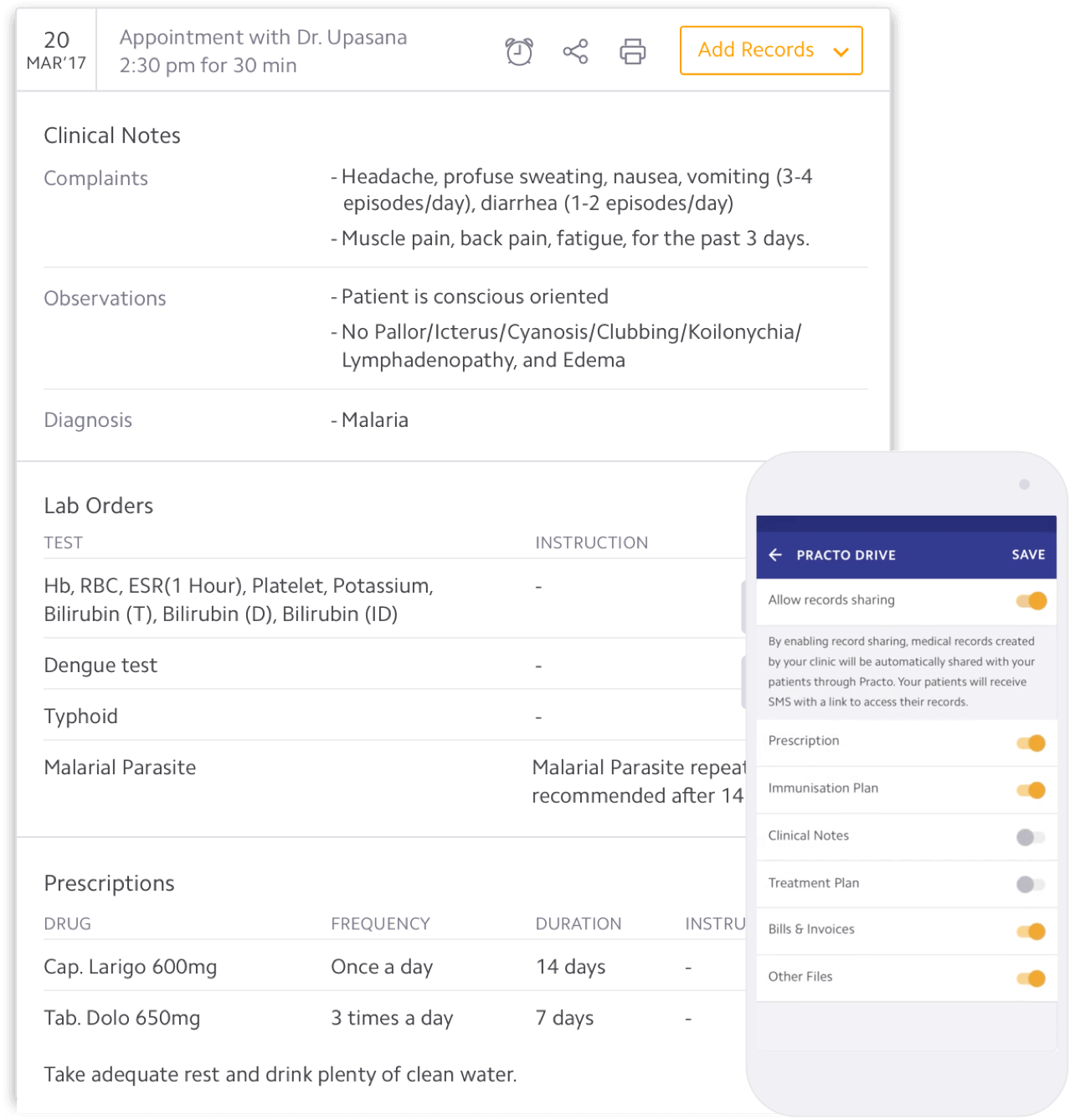
Record creation and sharing in Practo Ray - the Doctor assistance app
All medical records of the patient at one place by storing them in the cloud. We designed a system which ensured that only the patient can access their healthcare information.
Doctors can they automatically share records from Ray to the patient's health app. This entire exchange is created behind an incredible layer of security and end to end encryption. Doctors now save time, money, ink and paper.
Rethinking medical records
Even though we had eased the process of creation of records, these were still not usable or understood by patients. The primary research activity with 40 patients showed that the mental model by which doctors understand a health record was not the same as patients do. Hence, I took up the task to rethink the patient view of these records.
A New Temporal Structure
After iterating and designing many solutions, we (Hetang and me) came up with a model which worked the best for chronic patients. We suggested a spatial structuring of records, which meant categorizing the items into sections of upcoming, today and past.
Our secondary research showed that storing of past health records chronologically, though simple, is not the most optimum way. Doctors have been recently suggesting patients file records by problem types. A medical history organized solely by chronology does little to help a patient understand where they are and where they need to be on their health journey.
“Any patient's health-history is non-linear. Diseases come and go, against all logical and professional judgment.”
Hence, the temporal structure we suggested in not only chronological. It's also categorized on the basis of the problem helping both the patients and doctors to easily grasp the medical situation.

Temporal structure of medical records folder
Personal profile
Patient information is presented in a human way, not a readout from a database. We decided to show the not-so-sensitive medical details here. It gives a summary of the patient's personal data.
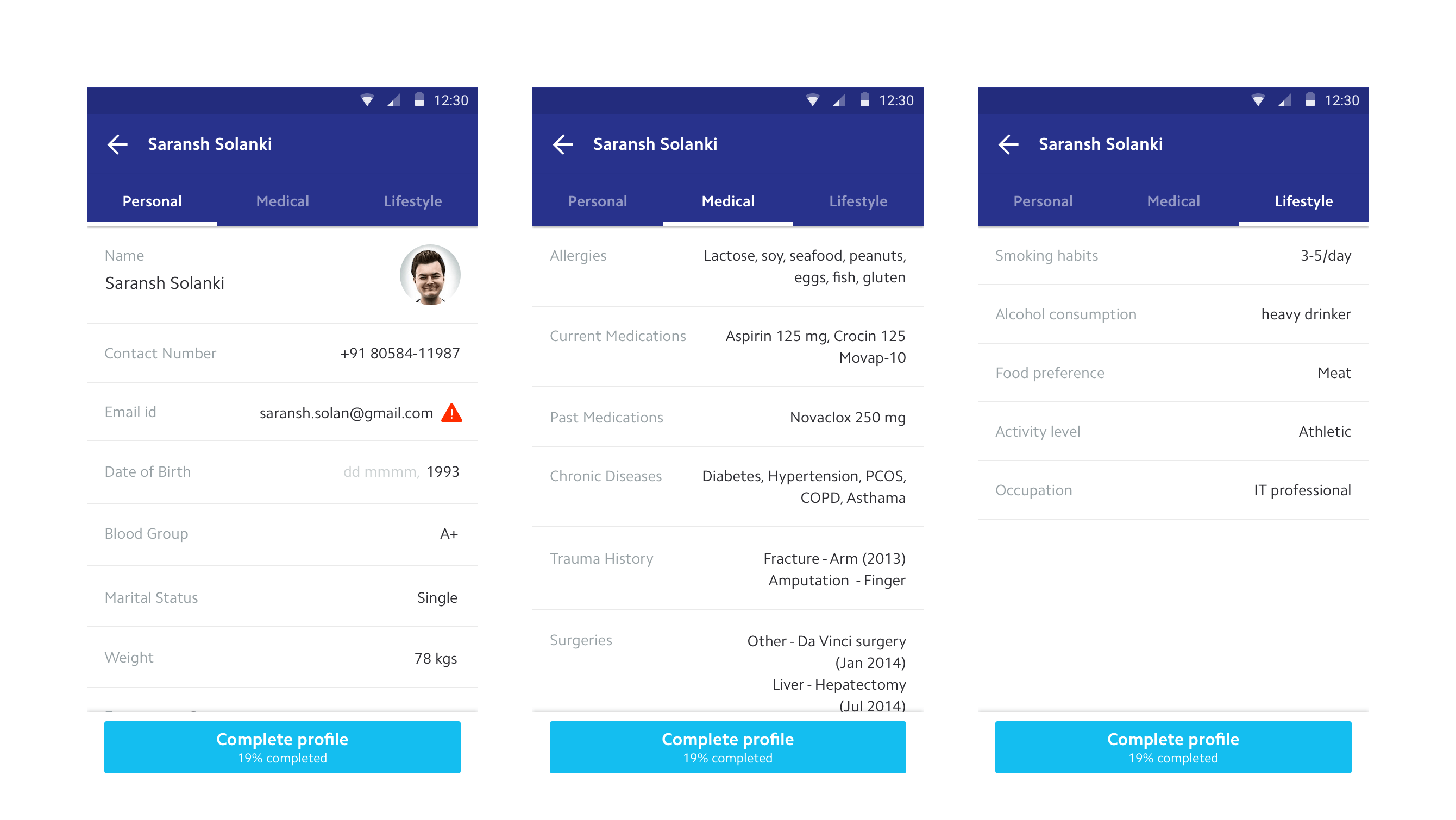
Patient's personal profile on the consumer app
Upcoming and Today
This is a section which talks about tasks to be done by the user today or in the future. They are shown reverse chronologically (nearest item first). These include upcoming appointments, reminders to take medicines, insights and other vital actions. This section is super personalized and dynamic, presenting only the most essential items.
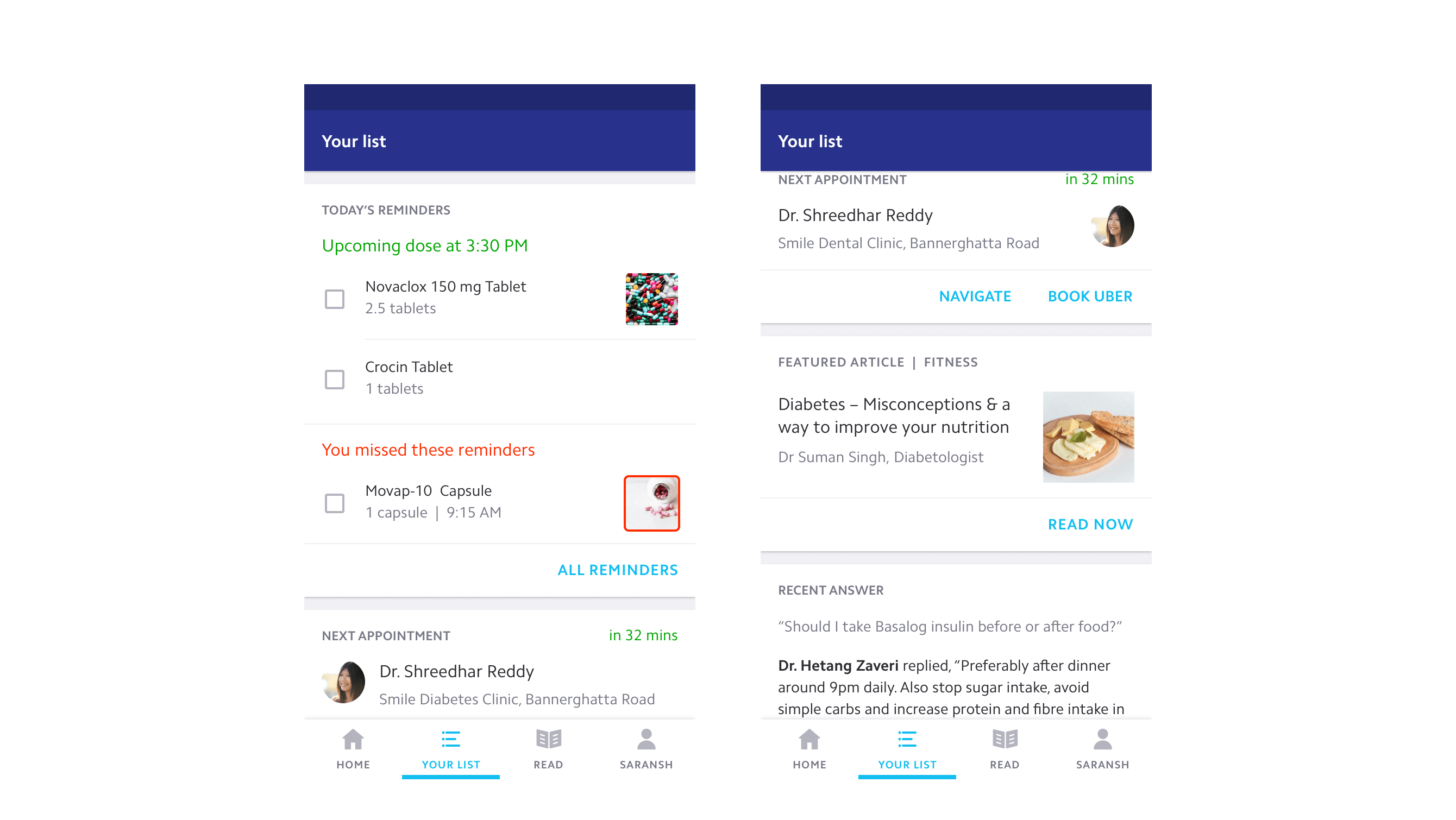
Upcoming reminders and other action items for the patient
Past
The items here are laid out chronologically while categorized on the basis of the problem helping both the patients and doctors to easily grasp the medical situation.
Our research shows that patients, especially chronic, do not remember a medical event by the exact date. The process to recall an incident which happened a couple of years back always leads to them recognizing the cause/diagnosis of the event.
For example, I remember having my ribs fractured a year back but not the date when it occurred or the doctor who diagnosed me or any other detail of the appointment. Hence the best identification anchor point for any health event in a timeline is its purpose (speaks a real story for the patient to recollect), which was made the title of the event. All prescriptions, records, and medicines are associated with this event.

Temporal timeline arranged chronologically with records linked to medical events which help in giving context to the problems
Historical information can become overwhelming as complications persist. They become hidden, increasing the cognitive load for doctors to consume that patient information. To solve this, I created a “snapshot” of the patient’s medical history. This helps the patient and doctors to keep track of multiple conditions developed during the years. The holistic health record brings together providers, visits, medications, and lab results, making it easy to keep track of things.

Patient's health history can be seen in a visually. Filter conditions to focus on a holistic view of the problems.
Medical Records - redesigned
Rather than having a singular template for each medical record, I designed every health record independently to make them more understandable and easy to consume. I tried to reduce the jargon and showed only what's important for the patients. I created actionable recommendations and digestible results. The content was rewritten so that it could be read as a natural sentence.
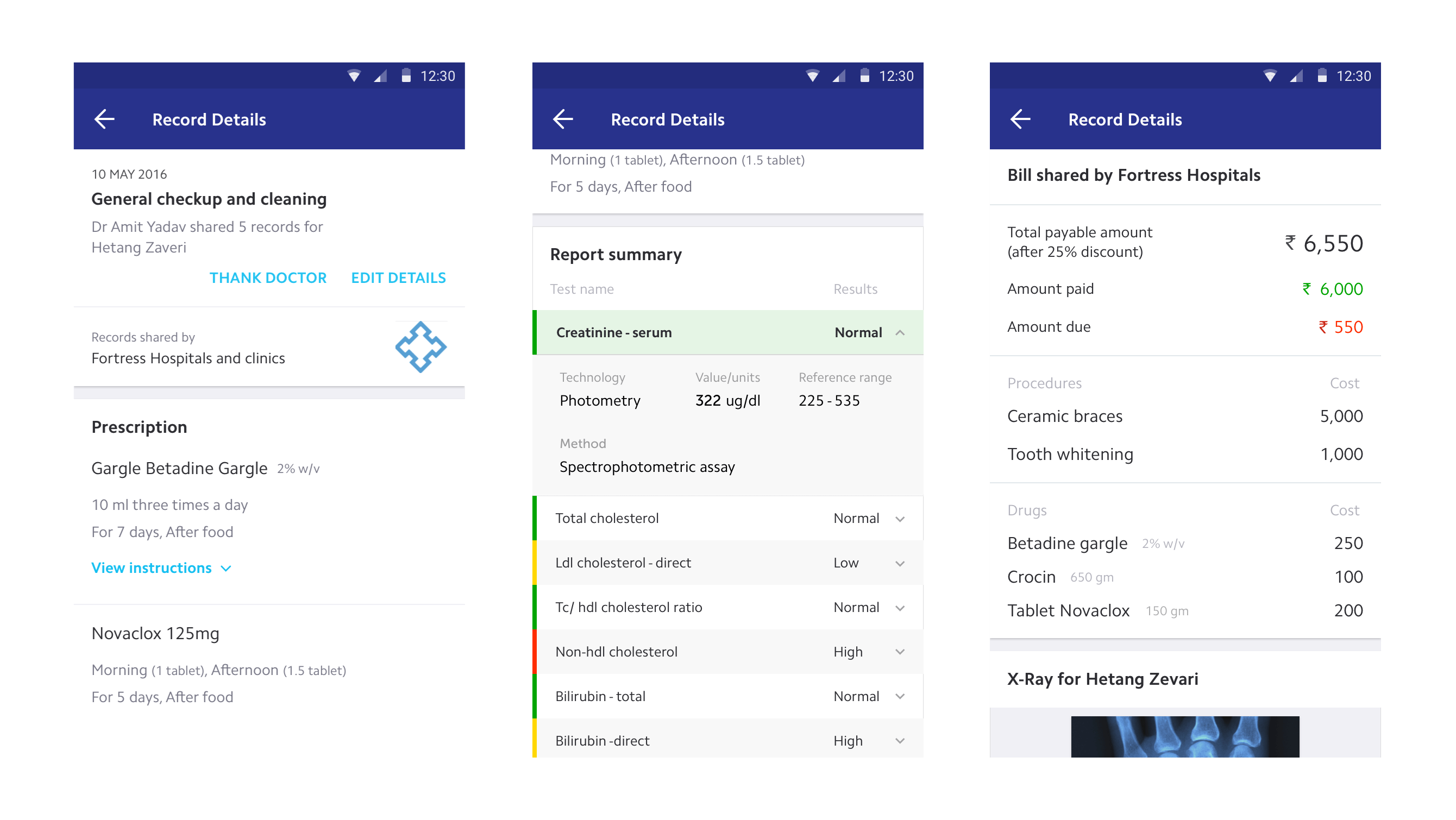
Simple list-based layout with correct text alignment to convey a rich amount of information in the best way possible
Supporting Tools
Chronic patients need to rely on family members to remind them to take medicines. At the same time, since there were doctors who did not use Practo Ray's record creation tool, patients still had a lot of paper-based records. Hence there was a need to assist patients and their caregivers to easily upload records and set-up reminders.
Self-upload records
A smart tool designed to help patients upload photos of the medical records onto the cloud. The feature, unlike a simple camera app, was designed to upload multiple records at the same time while adding a few extra data points. Patients, now can easily add records to their health app and access them from anywhere with ease. This also facilitated easy upload of prescriptions which were shared with a doctor before a consultation or a pharmacy for ordering medicines.
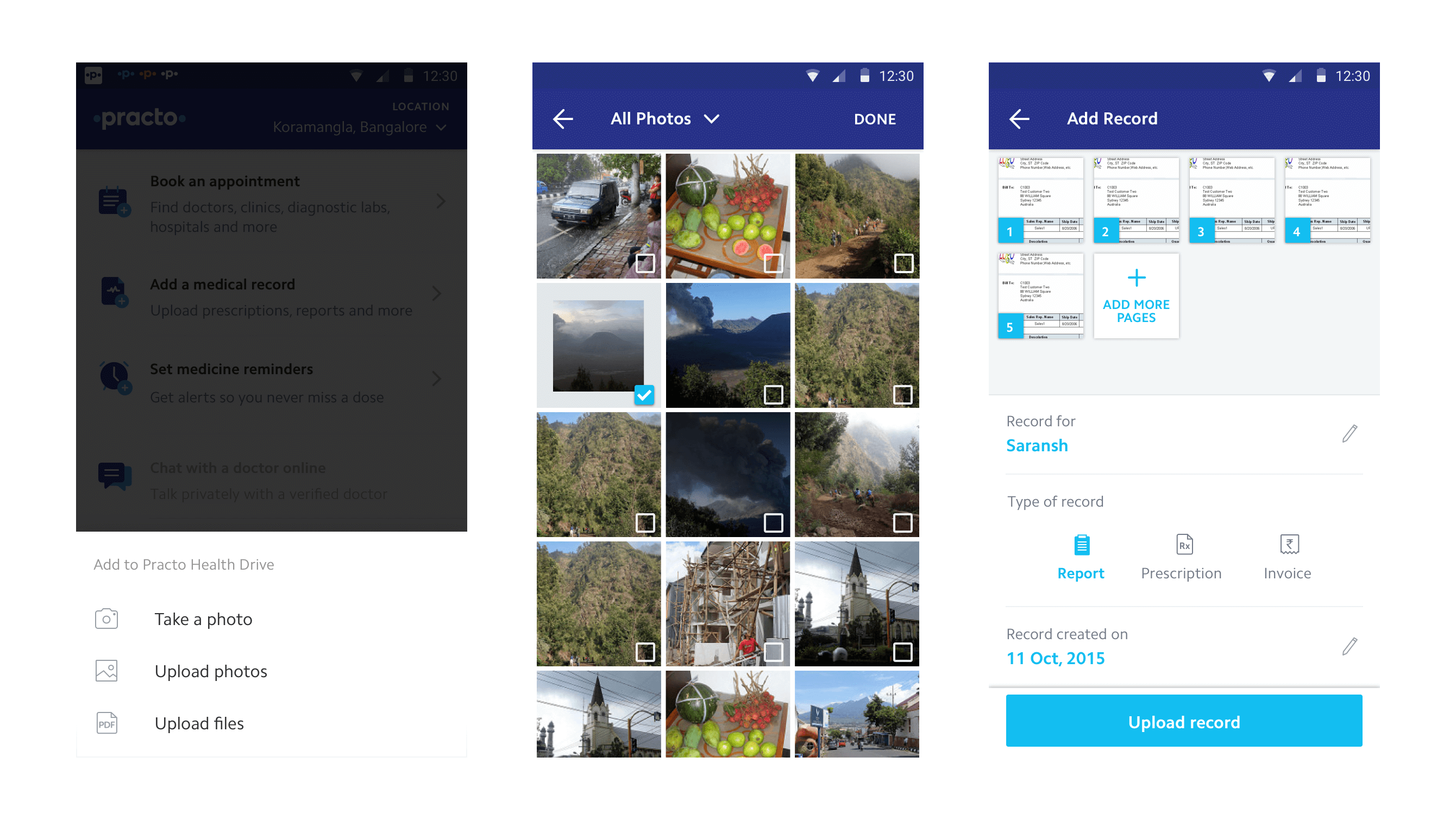
Bulk upload records onto Practo Drive with just two clicks
Setting up reminders
A seamless tool to prompt patients to take their medicines, drink enough water, or even take a break at work. Medicine reminder is one of the most patient-loved features on the mobile application. Patient's can also track their adherence to medicine intake which helps doctors and caretakers to provide them with better care.
A seamless tool to prompt patients to take their medicines, drink enough water, or even take a break at work. Medicine reminder is one of the most patient-loved features on the mobile application. Patient's can also track their adherence to medicine intake which helps doctors and caretakers to provide them with better care.
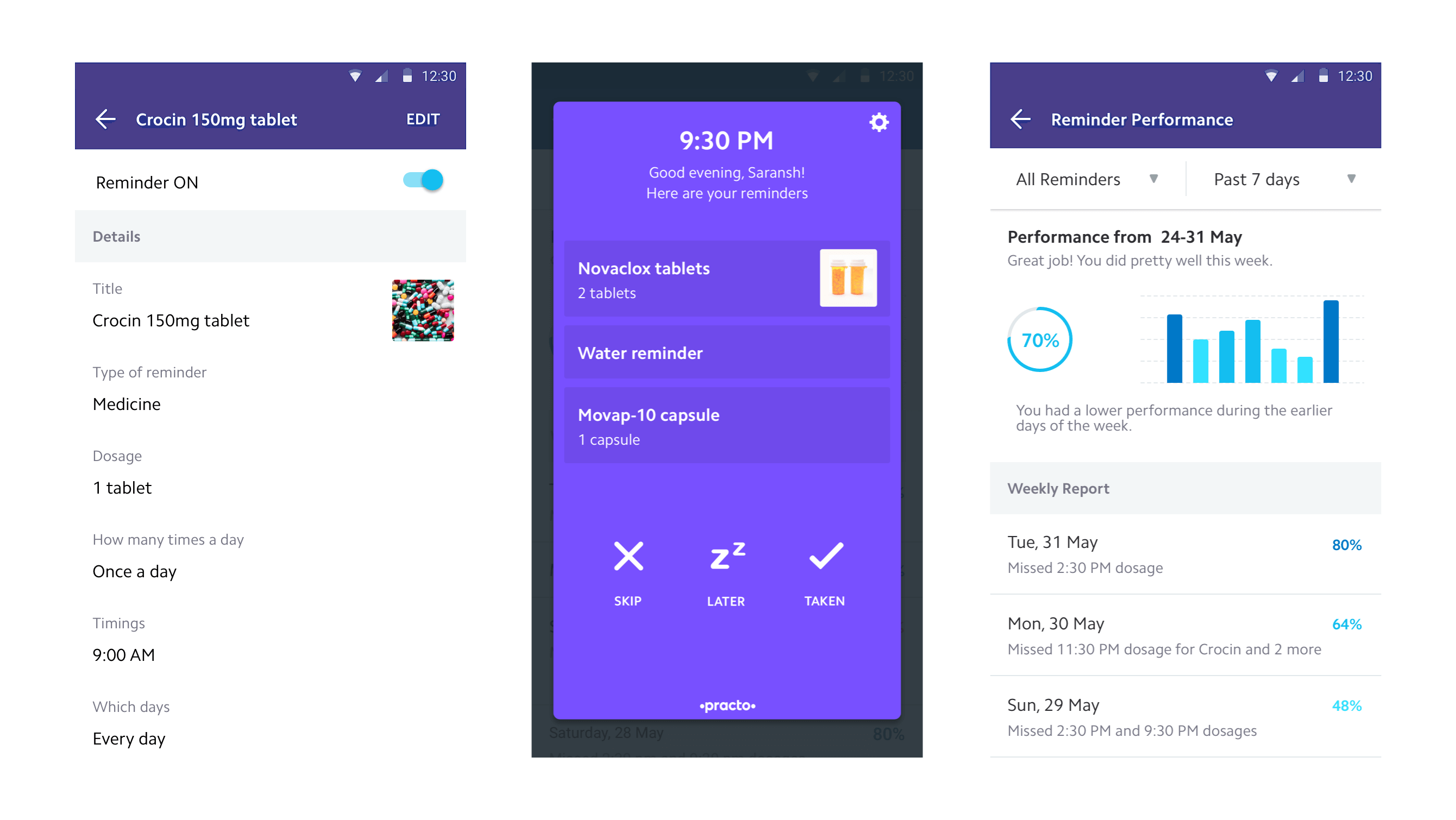
Reminders on the app reminders patients to take meds and track their adherence
More details on the Medicine Reminder's project can be viewed through the button below.
Read more
The released version
We launched the first version of PHR on the Practo app in November 2015. Since then the product has seen a lot improvement in functionality and usability. We have shipped more than six versions of the records module of the consumer app. At the same time, I built a seamless solution for doctors and other providers to share records with their patients online.
Though I have not reached the most optimum solution yet, I am proud of taking the first steps towards making accessible health records a reality.
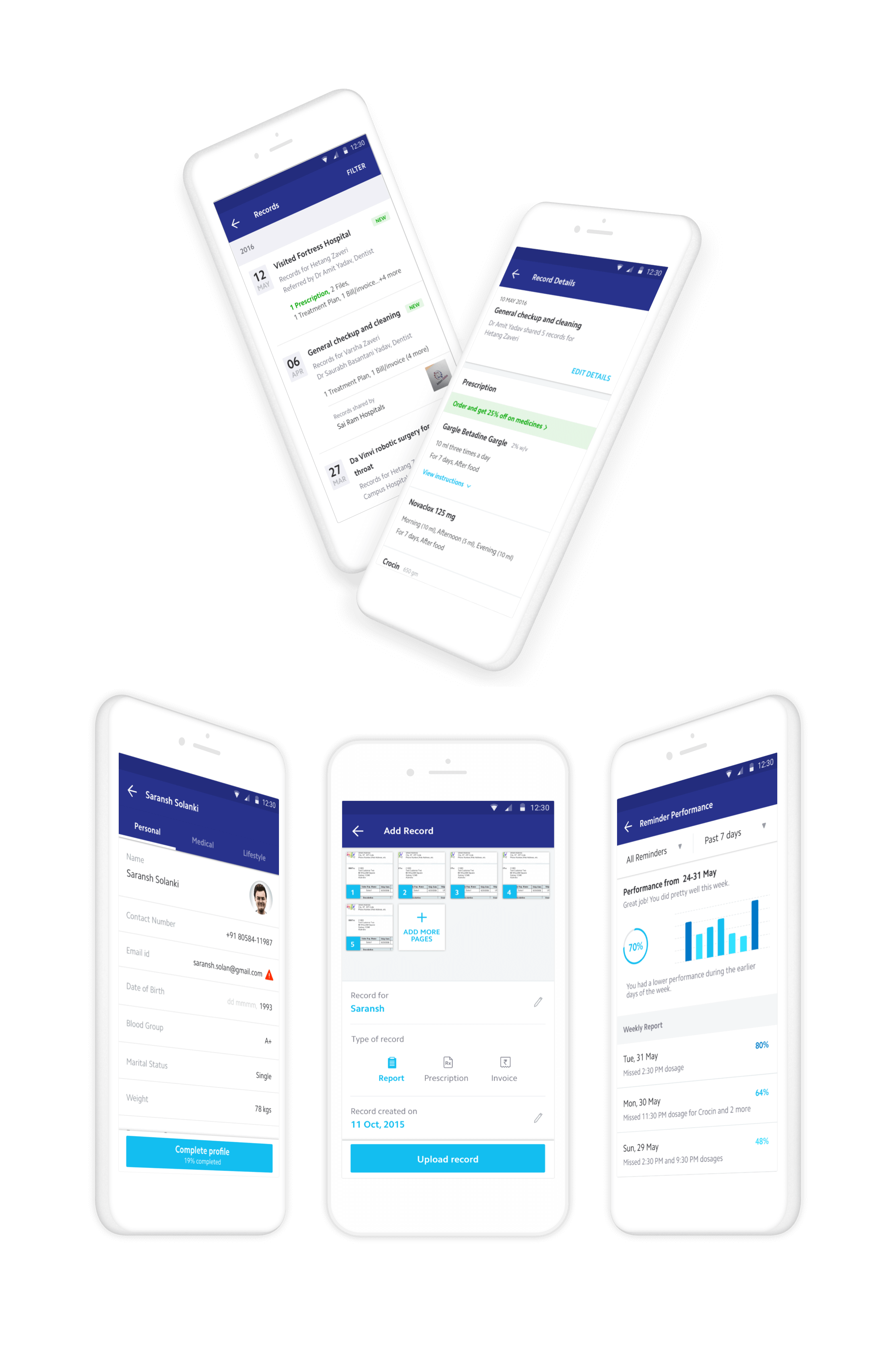
Outcome
PHR is one of the most critical aspects of healthcare and Practo's strategy. Patient's data helps us understand their needs and problems better. Since the launch of PHR on the Practo app, users have been using it extensively. We see incredibly high engaged users using features like the reminders and bulk-upload of records every single day.
- Patients, with whom digital records are shared, book 25% more appointments with the same doctor.
- 56 million records stored and shared securely
- Patients can access records from 8000+ medical centers